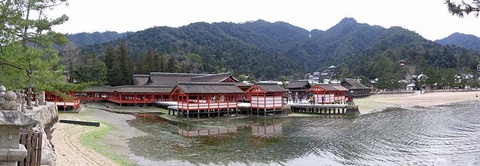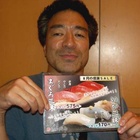I remember the moment when the dropping of the Atomic Bomb on Hiroshima finally hit me. I was interviewing Mrs. Hoshino of New Denver, B.C. some time in the early ‘90s. She was recalling the moment.
She and her family were interned at the Harris Ranch, in their home, sitting by the radio on the kitchen table. The way she explained hearing the first reports of the A-Bomb on August 6, 1945. What she said exactly wasn’t what I remember. It was really the moment of silence that followed, the “mokuso”; the closing of eyes and emptying of minds, the moment of human experience that really is beyond words.
I imagine that understanding what-it-is-to-be Nikkei at the time of World War Two wasn’t as difficult as it is now. We were in internment and P.O.W. camps and “they” were the ones who had confiscated our property, homes, and businesses in one of the biggest Canadian citizenship bankruptsy sales in history. We were branded with the same enemy label as those who bombed Pearl Harbor. Even though we understood our position differently. Canadians wanted to believe that there was an enemy in their midst and made it so.
The shock waves from Hiroshima must have thoroughly jarred something in the hearts of all Nikkei on that day. This massive expression of hatred was not only sending a clear message from the United States of America to Japan, but also implicitly all “Enemy Aliens”, prisoners of their own country, who were being taught an incredible lesson about democracy.
In the 55 years since the end of World War Two, Hiroshima and Nagasaki have become beacons of hope for the world peace movement. While the western consciousness may still struggle with the immense guilt of having dropped the atomic and plutonium bombs on Japan (the subject of PBS documentaries and historical debate) there are those, like U.S. war veterans, who still haven’t come around to figuring out the futility of war, and five years ago protested and eventually had the Smithsonian Institute’s planned 50th anniversary A-Bomb exhibit completely altered. A great deal of hatred still exists toward the Japanese. We Nikkei still often get painted with the same brush; it’s unavoidable.
I’ve watched my share of documentaries which try to offer some justification for the dropping of the bomb. Ignorant leaders at the highest levels refused to listen to the experts, including Albert Einstein who, seeing that Japan was already thoroughly defeated by the summer of 1945, was opposed to the use of the bomb. Japan was also at a point of using old men and women and young teens, armed with bamboo spears, like some kind of black comedy, against a country armed with a weapon that had the potential to truly send us all back to the Stone Ages. From the victims point of view, however, there is no justifying what they’ve had to continue to live with for the past 55 years.
* * * * *
I flew to Hiroshima on the evening of August 3rd, the flight is just 1½ hours (versus about 7 hours by Shinkansen), so I arrive in the evening, settling into the “Intelligent” Hotel conveniently located downtown.
The central area of Hiroshima looks strikingly the same as the downtown areas of most cities that I’ve visited. If they lack any distinctive quality, it is likely because they were all reconstructed at about the same time, probably by the same urban designers. The main covered shopping arcade streets here stretch in two directions. The city itself is located on a flat river delta surrounded by the Chugoku mountain range. The location of the Genbaku Dome (A-Bomb Dome) is where the Motoyasu and Hirokawa rivers intersect.
There is something eerily beautiful about the mushroom cloud that billowed into the heavens. Underneath, 160 meters northwest of the hypocenter, 580 meters above the city, is the Hiroshima Prefectural Industrial Promotion Hall, facing the Motoyasu River, designed by Czech architect Jan Letzel and completed in April 1915, at the beginning of the Taisho era (1912-26), a period of continuing rapid social change and military aggression, invading China and declaring war on Germany in 1914. Parallel to this, from 1908 to 1924, while the “Gentlemen’s Agreement” was in effect, 159,675 Japanese immigrated to the continental U.S.A.
William Randolph Hearst, the media giant, was one of the strongest anti-Japanese hate-mongers. One Hearst paper, The New York American, published the following poem in its July 23, 1916 edition,
HYMN OF HATE
They’re battleships, they say,
On Magdelena Bay!
Uncle Sam won’t you listen
When we warn you?
They meet us with a smile
But they’re working all the while
And they’re waiting just to steal
Our California!
So just keep your eyes on Togo,
With his pocket full of maps
For we’ve found out we can’t
Trust the Japs!
Of course, at the time the Nikkei community was struggling to get a foothold in the new land, overcoming barriers of language, culture, and prejudice which, for the Issei, the first generation of immigrants, slowed the process down. Indeed, many Japanese went to Canada from Hiroshima and neighboring prefectures, including Okayama and Yamaguchi.
In Canada, “Little Tokyo” in the Powell Street area of Vancouver was the center of the Japanese Canadian community, thriving on its own, serving as a gathering center for Nikkei living in surrounding communities in Richmond, Steveston, Strawberry Hill, West Vancouver, areas outside the city, and on Vancouver Island and the surrounding Gulf Islands. The community was united not only by blood but also by their hard work and ambition.
They worked as farmers, fishermen, shop keepers, and lumber mill workers. We had our own martial arts dojos and baseball heroes and legends like the Asahi. There were sentos (Japanese-style public baths), Buddhist temples, Christian churches, restaurants, movies and concerts by performers from Japan, schools where we learned to mix with other new Canadians and others where we learned to speak Japanese.
We still spoke Japanese to our parents (they never seemed to get the hang of English). We grew up following each others’ careers and lives with active interest; we understood that all of this bound us together some how, some way, and we knew that we definitely weren’t hakujin, although some made mad proclamations to be so.
Words like bon odori, senbei, jintori, Oshogatsu, geta, and yukata were still understood, and the way we lived with shikatta ga nai, gambatte, gamman, and enryo were the mysterious mantras that sustained us through the difficulties of fitting into a new land. Assimilation wasn’t thought possible by either the hakujin or Nikkei.
Nikkei challenged age old colonial ideas of the place of “yellow people” (that of being subservient) by working harder, being more industrious and studious so that even within a generation, many of their hakujin neighbors, began to feel threatened, composing hateful poems, and even holding demonstrations to show their solidarity in hatred.
The only way I can understand mad acts like internment or the A-bomb is to put myself in the shoes of the general hakujin public and try to feel the general atmosphere of fear, ignorance, and prejudice that existed then. Sadly, it isn’t unusual that I meet Canadians (even in Japan) who continue to rationalize internment as a necessary act. Was Redress all for not? Similarly, I’ve yet to meet a Japanese who’s ever seen the need to drop the A-bomb and, even less so, the plutonium bomb that was dropped on Nagasaki three days later.
Like Mrs. Hoshino and the Harris family, as they sat around the kitchen radio in the main house on a property with magnificent views of Slocan Lake, the surrounding Valhalla mountains; down below to Rosebury, New Denver, at the “San,” through the Orchard, down the way to Sandon, Slocan, Lemon Creek, Bay Farm, and on the other side of the valley in Kaslo; through the prairie beet farms in Alberta and Manitoba, further east even to Angler P.O.W. camp further east to Petawawa; I imagine the panic, concern, and horror that must have raged through the Nikkei community on that day when something universal ceased in the heart of humanity.
August 4, Miyajima
My first morning in Hiroshima, I head to Miyajima, specifically to see the often photographed Itsukushima Shrine, the vermilion torii, Shinto gateway in the sea, a World Heritage Site and one of the Top 3 designated “must see” sites of Japan (the other two are Matsushima in Miyagi and Amanohashidate on the Japan Sea).
The day is another scorcher which I seem to be getting used to. I take a streetcar all the way from downtown Hiroshima to the port, about one hour. It costs only 270 yen. From here I catch a ferry for Miyajima. I watch a gaggle of gan garus, with some amusement their deep tans, candy colored clothing, blond dyed hair, and 20 cm high shoes negotiate the metal stairways, a couple showing remarkable dexterity by even chatting on the “piichi” portable phones, following the groups conversation, and balancing their dangerously high shoes at the same time!
A welcoming committee of hungry deer greet you at the exit from the terminal building. A lot of my friends in Japan get “templed out” when they visit certain touristy places. I really relish my time in different Buddhist temples (otera) and Shinto shrines (jinja), for they are fundamentally the same, but if you spend a little more time looking at details, they are surprisingly different.
Itsukushima Jinja was founded in 592 to honor three female deities. The majority of the shrine buildings are believe to date from the 16th century architecture, while being repaired repeatedly through the centuries. Around 1619, the island enjoyed an active creative period of Noh plays and bustling markets in the spring, summer, and fall.
Hanging out in Buddhist temples is also a good way of staying cool on a hot day. (Unfortunately Shinto shrines, given their design, don’t offer similar shelter.) I wander around the main shopping arcade area and am surprised by the extensiveness of it. Despite being an island on 18 square kilometers in size, there is a modern shopping area obviously geared towards tourists, places to lunch at, touristy shops that feature shamoji (wooden rice scoops), which are said to originate with the famous Buddhist priest Seishin in the Tenmei (1781-1789) and Kansei (1789-1801) eras promoted local public works such as well digging and had the inspiration to invent the shamoji that’s used in every kitchen.
I walk over to Momijidani Park and splash around in a stream that runs through it, further up there is a cable car that runs up to the top of Misen, but the day is hot and, as is usually the case for someone who has spent some years in Vancouver and Nelson, B.C., the mountain scenery I’ve seen here so far has been disappointing. I have a natural aversion for the obvious tourist trap, anyway.
Instead, I head back down to the vicinity of Itsukushima shrine and decide to spend some time in the cool confines of the Municipal History and Folklore Museum. It’s a Friday, but I’m the only person there. It’s a large sprawling, comprehensive museum. I get a good idea of what life was like for the merchant class 170 years ago, a narrow frontage and long depth, tatami (rectangular shape mats: straw covering a core to tightly woven rice straw) floored rooms, sliding shoji doors, rooms that litrally open into each other. The merchant class may have been at the bottom of the social order (1. religious people 2. samurai 3. farmers 4. merchants), but they sure had it good!
*This article was originally published in the September 2000 issue of the Nikkei Voice.
© 2000 Norm Ibuki









